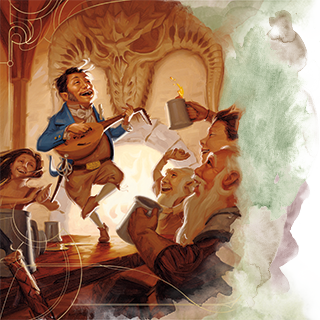
This is a supplemental background for players who want to have a better idea of how to roleplay a character with anxiety. As this is supplemental there will be no major proficiency, and the feature will tie in more to role-play than gameplay. There are a number of different types of anxiety, and this background will go into these various types, along with general attributes of anxiety, and the basics you need to know when creating and playing as an anxious character.
What to know about playing as an anxious character: Anxiety, in whatever form it shows up in, is something that affects every aspect of your character. A character that suffers from anxiety will have an extra dimension that needs to be applied to most situations. For example, an anxious character might be more wary, less inclined to trust, ore alert and on guard than a character that does not deal with anxiety, which may affect their interactions with the party members. Anxiety is fear, fear of the known or unknown, but while normal fear is something easy to get rid of, anxiety is fear and worry that is ever-present, something that never truly goes away, it is only quieted. It is often represented as a person shattering themself in an attempt to stay whole. Along with the anxiety often come emotional repercussions for the character. For example, if they allow their anxiety to rule them , they might feel embarrassment. They might go into an avoidance routine, which will end with them experiencing grief about their avoidance that then spirals back into anxiety.
The most basic form of Anxiety, Generalized Anxiety, is also the most recognizable form of anxiety. It is what everyone thinks of when they think of anxiety. Excessive anxiety or worry about a number of things. characters with GED find it very difficult to control their anxiety, and find that it seeps into every aspect of their life. Some of the symptoms of GED are: Restlessness, fatigue, difficulty concentrating, irritability, muscle tension, sleep disturbance. all along with excessive anxiety that has been going on for a long time, at least half of a year or so.
Other types of anxiety:
Social Anxiety: This is anxiety focused directly around social situations. In this case, the character experiences all of the symptoms of anxiety, but only around crowds of other beings or when in public situations.
Specific Phobia: This anxiety is similar to generalized anxiety, however it is tied in to a very specific thing. It can be an animal like a spider, or something inanimate, such as a statue, or something like the rain or thunderstorms.
Agoraphobia: Agoraphobia is the fear of the outside, of the unknown. While this is not usually applied to player characters, introducing an agoraphobic NPC might work well in furthering their characterization.
Anxiety comes in many forms, however a common characteristic of those suffering from anxiety is that they are alert. They are aware of what is going on with them and around them. They might have a higher than normal Perception, for example. The reasoning behind this is as clear as it is tragic: the need to feel safe. When someone is dealing with worry and fear on a constant basis, they will do what they need to keep safe. In a role-play setting, this can translate to the character always being alert and having a lot of trouble with feeling like they are constantly not safe. The character will do what they can to make them feel as safe as possible, even if they feel like it is pointless.
Suggested Characteristics
For an anxious character: First, define their anxiety
Panic disorder is a variant type of anxiety that is focused around panic attacks: abrupt surges of intense fear/discomfort that lasts for a short period of time (the anxiety attack peaks over the course of a few minutes, and can last for up to an hour or more). During a panic attack, you are not in control of your body. Panic attacks are random, in that they are unexpected and have no obvious triggers for the panic to appear. This is terrifying for the participant, as they have no obvious way of predicting or preparing for their body to suddenly go haywire at any time. Most people who suffer from panic attacks change their behavior in a way to try to minimize the effect of future panic attacks, such as informing anyone they feel safe with about their condition, always being prepared with emergency supplies (extra food, warm blanket, extra water, painkillers or herbal numbing treatments, etc...
Symptoms of a panic attack: Accelerated heart rate, uncontrolled sweating, shaking, feeling like they can't breathe or are being smothered by something, choking, chest pain, Nausea, feeling dizzy or faint, experiencing chills or heat, feeling numb, derealization (feeling that nothing is real around them) or depersonalization (feeling detached from your body, like an outsider looking in) Fear of losing control or going crazy, and fear of dying. A panic attack can consist of all of these symptoms or only just a few.
Role Playing: Panic attacks are random, that is a core of what they are. Ask your DM to role a die every so often, and if the roll is a crit fail, have your character go into a panic attack.
Remember: Panic attacks can happen without a character having Panic Disorder. In that case, the attack is often triggered by something in particular, such as a past trauma or something that signifies that past trauma to the client. Panic Disorder means that the character has no idea about what could be causing it, the triggers that could happen, or how it interacts with any of the characters own personal traumas.









Comments